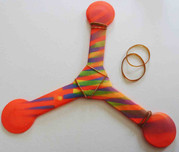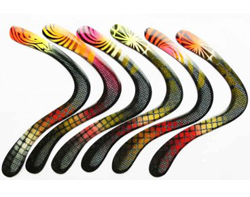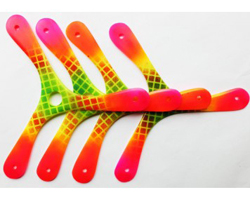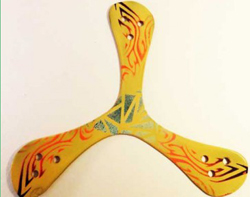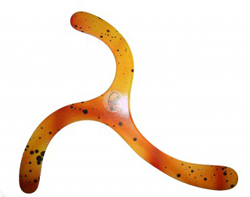Pas de produit
Modifier son boomerang
Tous nos boomerangs ont été selectionnés afin d’être accesssibles à tous.
Ils sont faciles à lancer et à rattrapper dans des conditions météo allant du vent nul à un vent un peu plus soutenu.
Dès que le vent est plus fort et que les conditions climatiques deviennent difficiles, votre boomerang peut devenir imprévisible, il peut se faire embarquer par le vent et revenir trop rapidement.
En compétition, il existe quelques astuces afin d’améliorer la tenue au vent de son boomerang ou tout simplement le freiner pour un rattrapage plus facile.
Voici donc les principales astuces utilisées en compétition.
Faciles à mettre en oeuvre, elles vous serviront à adapter votre boomerang à votre geste.
Les élastiques
Les élastiques sont le moyen le plus simple pour modifier le vol de votre boomerang.
Dès que vous sentez que le vent se renforce, nouez une élastique à l’extrémité d’une des pales.
Si une élastique ne suffit pas, recommencez l’opération sur une deuxième pale, puis une troisième.
Expérimentez et placez les élastiques à différents endroits du boomerang, ce qui donnera des effets différents.
Les élastiques ont pour effet de casser la rotation du boomerang et d’augmenter légèrement sa portée, ce qui en cas de vent soutenu, contribuera à ralentir sa course afin que vous le rattrapiez plus facilement.
Les « Flaps »
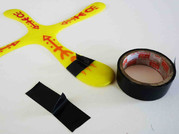
Tout comme les élastiques, les Flaps sont un moyen simple pour modifier le vol du boomerang.
Il s’agit ici d’utiliser du scotch type « Chaterton ».
Coupez un morceau de scotch d’environ 6 cm, repliez-le au centre sur une largeur de 1 cm environ puis collez-le tout en bout de pale.
Le flap contribuera à freiner votre boomerang sans modifier sa portée.
Expérimentez cette technique en modifiant l’emplacement du (ou des flaps) que vous avez positionné(s) sur votre boomerang.
Les trous
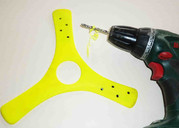
Les élastiques et les trous ne modifiaient pas le boomerang ?
Pour un débutant qui vient d’acquérir un boomerang, faire des trous est impensable !!!
C’est pourtant l’une des techniques les plus utilisées en compétition.
Faire des trous permet de freiner efficacement son boomerang et d’améliorer sa tenue au vent fort.
Cependant, il faut être prudent car une fois le trou percé on ne peut plus revenir en arrière.
Il faut donc y aller progressivement. Le diamètre des trous peut varier de 6 à 8 mm.
Commencez par un trou au bout de chacune des pales, puis allez tester votre boomerang.
Si le résultat n’est pas celui escompté, continuez jusqu’au vol idéal.
Le plomb
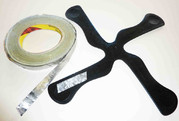
Vous pouvez facilement augmenter la portée de vos boomerangs en lestant chacunes des pales.
Voir un boomerang évoluer sur de grandes distances est un fabuleux spectacle.
Si vous désirez augmenter la portée de votre boomerang, vous pouvez tout simplement scotcher une pièce de monnaie (5, 10 ou même 20 cts) en bout de chaque pale.
Votre boomerang sera plus lourd et il vous faudra le lancer en conséquence.
Le mieux est d’utiliser du scotch de plomb, ce qui permet d’atteindre progressivement le poids idéal de votre boomerang.
Variez l’emplacement des lests afin d’obtenir des effet différents.
Dièdres et incidences
Si vous observez votre boomerang, vous constaterez qu’il est profilé comme une aile d’avion avec un côté plat et un côté profilé.
En travaillant sur les dièdres et les incidences, il est possible de modifier le vol de votre boomerang.
Les boomerangs en matière plastique sont les plus appropriés pour travailler les dièdres car ils peuvent facilement conserver le réglage que vous lui donnez.
Dièdre positif
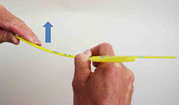
Il s’agit de monter légèrement l’une des pales de votre boomerang vers le haut afin de lui donner une trajectoire montante.
Si vous estimez que votre boomerang plonge trop en milieu de vol, appliquez-lui cette torsion et il aura alors une trajectoire plus haute.
Vous pouvez ensuite twister une seconde pale puis une troisième pale selon l’effet recherché.
Un dièdre positif est souvent nécessaire afin d’atteindre une trajectoire haute dans le cas d’un boomerang destiné à effectuer des rattrapages acrobatiques.
Dièdre négatif
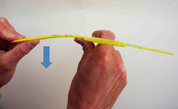
Il s’agit là d’obtenir une trajectoire basse et rasante.
Abaissez légèrement l’une des pales de votre boomerang puis testez-le, faites de même sur les autres pales si l’effet n’est pas suffisant.
Mais attention, trop de dièdre fera s’écraser votre boomerang à mi-course.
Les lanceurs experimentés dièdrent leur boomerangs de vitesse de cette façon afin d’obtenir une trajectoire rapide et rasante.
Incidence positive
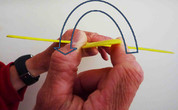
Il s’agit ici de diminuer ou d’augmenter la portée du boomerang en vrillant légèrement au moins une des pales de votre boomerang.
Si vous vrillez une pale en montant le bord d’attaque, on appelle cela une incidence positive.
Une incidence positive aura ainsi pour conséquence de diminuer la portée de votre boomerang mais diminuera également sa rotation.
Il ne faut pas trop vriller la pale car le retour serait trop ralenti.
Si vous estimez que votre boomerang boucle devant vous, ce type de réglage peut résoudre votre problème.
Incidence négative
Si vous vrillez légèrement l’une des pales en abaissant le bord d’attaque, on appelle cela une incidence négative.
Cette incidence négative aura pour conséquence d’augmenter la portée de votre boomerang.
Mais attention, il faut agir par petites touches.
Trop d’incidence aura pour conséquence un mauvais retour car votre boomerang sera beaucoup moins précis, il bouclera devant vous et pourra même aller tout droit sans amorcer la moindre courbe.
Il est donc conseillé d’utiliser ce réglage avec parcimonie.
Conseils
Nous vous donnons ainsi les clés pour obtenir un vol adapté à votre lancer.
Chaque lanceur est différent et doit adapter ses boomerangs à son geste qui lui est propre.
Notre conseil : testez, essayez toutes ces techniques en les associant.
Avoir un vol parfait dépend des conditions climatiques, du boomerang et du lanceur.
En général, les compétiteurs ont un boomerang adapté pour chaque type d’épreuve et pour chaque condition climatique.
HOW TO MODIFY YOUR BOOMERANG
All of our boomerangs were selected to be affordable for everyone. They are easy to throw and catch in all weather conditions from no wind to strong wind. When the wind is stronger and the weather conditions become difficult, your boomerang can become unpredictable. It can be carried away by the wind and come back too quickly. During a competition, there are some tricks for improving the boomerang’s wind resistance. The idea is to simply slow it down to allow for an easier catch. Here are the main tricks used in competition. Easy to implement, they can be used to adapt your boomerang to your technique.
Rubber bands: Rubber bands are the easiest way to change the flight of your boomerang. When the wind strengthens, tie a rubber band at the tip of a blade. If one rubber band is not enough, do the same thing on a second blade, then a third. Experiment and put rubber bands in different parts of the boomerang, which will give different effects. The rubber band reduces the spinning effect of the boomerang and slightly increases its range, which in the case of strong wind, helps to slow its course so that you catch it more easily .
Flaps: Like rubber bands, flaps are a simple way of changing the boomerang’s flight. Use scotch or duct tape. Cut a 6 cm piece of tape, fold it in the center so it has a width of about 1 cm and then paste this on the blade’s tip. The flap will help curb your boomerang’s flight without changing its range. Experiment with this technique by changing the location of the flaps on your boomerang.
Holes: Rubber bands and tape didn’t do the trick? It’s unthinkable for a beginner to put holes in his/her boomerang but in competitions, it’s one of the most common techniques! Making holes can actually slow down the boomerang and improve its resistance to strong wind. However, one must be careful because once the hole is made there’s no going back. The diameter of the holes can vary from 6 to 8 mm. Start with one hole and proceed carefully until you achieve the perfect flight.
Lead: You can easily increase the range of your boomerangs by weighing each blade. Seeing a boomerang travel long distances is a fabulous sight to behold. If you want to increase the range of your boomerang, you can simply tape a coin (5, 10 or even 20 cents) on each blade’s tip. Your boomerang will become heavier and you will have to adjust your throw accordingly. The best is to use lead scotch, in order to gradually reach the ideal weight for your boomerang. Vary the location of the weights in order to obtain different effects.
Dihedral and anhedral angles: If you observe your boomerang, you see that it is tuned like an airplane’s wing with a flat side and a tuned side. Working on your dihedral and anhedral angles can help you change the flight of your boomerang. Plastic boomerangs are the most suitable for working dihedrals because they keep their settings.
Positive dihedral: You want to slightly bend one of your boomerang’s blades upwards to give it a more vertical path. If you find that your boomerang dives too much mid-flight, apply this torsion and it will thus have a more vertical path. You can then twist a second and a third blade according to the desired effect. A positive dihedral angle is often necessary to achieve a high path on Trick Catch boomerangs.
Negative dihedral: The goal here is to obtain a low and skimming path. Slightly bend one of your boomerang’s blades downwards and then test it. Repeat on the other blades if the effect is not enough. But be careful, too much dihedral will cause your boomerang to crash mid flight. Experienced throwers tune their speed boomerangs down in this way to obtain a fast and skimming path.
Positive anhedral: The idea here is to either decrease or increase the range of the boomerang by slightly twisting at least one of your boomerang’s blades. If you twist a blade by bending up the leading edge, it is called a positive anhedral. A positive anhedral will then reduce the range of your boomerang but also decrease its spinning. Be careful not to twist the blade too much since the return may be too slow. If you find that your boomerang loops in front of you, this type of setting can solve your problem.
Negative anhedral: If you slightly twist a blade by bending down the leading edge, it is called a negative anhedral. This negative anhedral will then increase the range of your boomerang. But be careful and do it incrementally. Too much negative anhedral will result in a bad return and your boomerang will be much less accurate. It may even loop in front of you or fly straight without any curve. It is therefore recommended to use this modification sparingly.
ADVICE: We have now provided you with some tips for achieving the perfect flight and throw. Each thrower is different and has to adapt his/her boomerangs to his/her own technique. Our advice? Test and try out all these techniques for yourself. A perfect flight depends on weather conditions, on the boomerang itself, and on the thrower. Competitors are typically equipped with a specific boomerang for different weather conditions and events.

